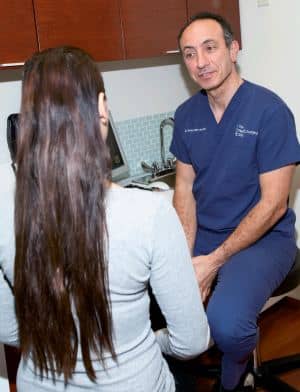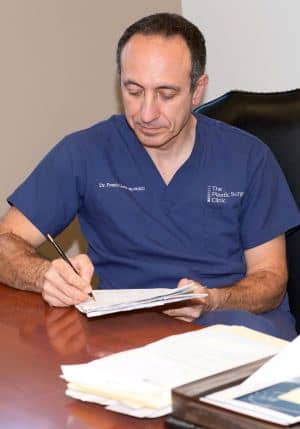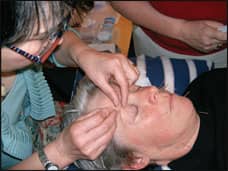
Lista spoke proudly about his sojourn to Haiti to perform surgeries on earthquake victims.
PHOTOS BY PETER MINTZ
Less than 1 month after the devastating earthquake hit Haiti on January 12, 2010, Toronto plastic surgeon Frank Lista, MD, and a handful of his colleagues were on a plane bound for Port-au-Prince.
The operating facilities at the Haitian Community Hospital in Port-au-Prince were a far cry from the modern surgical suite where he regularly performs breast augmentation and other aesthetic procedures, but Lista and his team hit the ground running. Literally. They changed into their scrubs and began operating amid the rubble and ruins almost immediately.
“We didn’t stop for a week,” he recalls. During this time, they completed 35 reconstructive surgeries. “Most disasters are public health emergencies, but Haiti was different because although 200,000 people died right away, there were two to three times as many who were trapped, and not killed.”
Many of these individuals were severely disabled and had chronic wounds. “Haiti required more orthopedic and plastic surgeons than other medical disciplines, and that is unusual in the history of disasters,” he says.
So many stories and unsung heroes stand out in Lista’s mind, including a fearless father who dug his 8-year-old son out from under the rubble of a demolished schoolhouse.
“He dug for 18 hours and found his son still alive, and he saved five other children in the process,” he says. All the skin was removed from the small child’s arm, and Lista and his team helped to reconstruct the limb.
K. Leslie Gillanders, who has been Lista’s patient coordinator for 10 years, was one of the staffers who made the trek. “It was incredible to see what they could do with so little,” she recalls.
Lista’s skill, vision, and direction helped Gillanders and others to stay focused on the goal of the trip to Haiti. Whether in Port-au-Prince or in Canada, Gillanders considers Lista “very straightforward, and when something needs to be done it needs to be done,” she says. “That is the bottom line.”
This can-do attitude combined with a holistic approach helped the team provide much-needed care for many injured in the earthquake. Lista worked hand-in-hand with the Haitian nurses to make sure that nothing fell through the literal or figurative cracks. He gave them instructions on how to monitor and tend to the reconstructive patients.
“He really wanted to do as much as he could to implement a ‘transitionary’ format,’ ” Gillanders says.

Lista’s Toronto-based practice focuses on breast surgery procedures.
BACK IN CANADA
While not a typical week for Lista and his associates, the sojourn to Haiti made this one memorable. All of his time in Haiti was spent performing reconstructive surgeries, but more than 90% of his Toronto and Mississauga practices are devoted to aesthetics.
“Most people think of reconstructive and aesthetic plastic surgery as opposite ends of the spectrum, but the common denominator is that they are both about making people feel better about themselves,” Lista says.
This holds for breast augmentation with implants, rhinoplasty, tummy tucks, and reconstructive surgeries.
Breast augmentation with implants is perhaps what Lista, the founder and past president of the Ontario Society of Plastic Surgeons, is best known for among his peers. And in this area, Lista has some cogent advice for his US-based colleagues.
It all comes down to choices and exploring your options, he says. “The mistake most surgeons and patients make is that they come in with the idea that there is a ‘best implant,’ ” he says, yet there is no best breast implant or one-size-fits-all approach. “Different patients need different things,” he adds.
There are different manufacturers, different fills, different coatings, different shapes and textures, as well as projections, he says. “The most successful plastic surgeon will know the difference between all of these implants, but some surgeons use only one style by one manufacturer,” he notes.
These may be their go-to implants because of their comfort level and familiarity. There may be some physicians who are getting a kickback from the manufacturer. “That is terrible. We don’t take money or gifts. We use both implant companies,” he says, referring to Mentor Corp and Allergan Inc.
In addition, Lista has developed a simple algorithm to match the best breast implant with any given patient. This forms the basis of one of his most popular talks at industry meetings.
“Use the implant with the best aesthetic result, and if it doesn’t make a difference, go with the one with the least complications for that patient,” he says.
NOT THE BREAST OF TIMES

Lista offers that there really isn’t much difference between Canadian and US plastic surgeons.
If Lista’s work in Haiti has been one of the high points of his career, then the low point was reached when the FDA and the Health and Welfare of Canada put a moratorium on silicone gel-filled breast implants in 1992.
While Canada reintroduced the implants in 2000 via a special government program, in the United States it was not until 2006 that the FDA reapproved the sale of two brands of silicone-filled breast implants.
Unfortunately, the damage had already been done, Lista says, adding that the moratorium had a chilling effect on his practice, the practice of plastic surgery, and on plastic surgery patients, as well. “It set plastic surgery back about 10 years,” he says.
“Now we have a whole generation of plastic surgeons who have no experience with the use of silicone implants,” he says. “This did a huge disservice to patients and the profession.”
One thing Canada has that United States still doesn’t are highly cohesive silicone gel or “gummy bear” implants. When they are eventually approved in the United States, gummy bear implants may be best suited for a patient with some ptosis and wants the implant placed above the muscle. “This will give a natural lift,” Lista says.
Speaking of emerging plastic surgery procedures and products, Lista is not in favor of some of the new noninvasive body-contouring methods. “They are disappointing,” he says. “It is all about expectations. If you see a plastic surgeon, you expect more results than you would get from, say, a spa procedure.”
Put another way: “You don’t expect much if you spend $200 at a spa for someone to place hot rocks on your body,” he says. “If someone comes to a plastic surgeon and I say, ‘I will pass microwaves through your body and you will lose weight,’ you will expect something to happen.”
It usually doesn’t.
Minimally invasive often means minimally effective, he says. “Some of these procedures are extremely expensive, and their results are minimal, to say the least.”
CARRY THE NEWS
In Canada as well as the United States, the biggest trend is that cosmetic surgery is out of the closet and into the limelight. “Twenty-five years ago, plastic surgery was a secret,” he says. “Patients would come in and say, ‘I don’t want anyone to know and haven’t told a single person,’ ” he says.
Not anymore. “Now people come in with parents, spouses, girlfriends, boyfriends, and in groups,” he says, and this certainly helps build a practice. “The best ad is doing great surgery and having patients who are really happy tell their friends,” he adds.
This is the sort of word-of-mouth that lifts a practice above all others, and is one of the ways that Lista has become known as one of Toronto’s top plastic surgeons.
Lista is not the all-work-and-no-play type. When he is not saving lives in Haiti or performing breast augmentation or other cosmetic surgeries in Toronto, Lista reads books about history, architecture, and art. The marathon-running father of two has also been married to the same woman for 30 years.
Denise Mann is a freelance health writer in New York. Her articles regularly appear in WebMD, health.com, cnn.com, Arthritis Today, American Profile, and special sections of The Wall Street Journal. She is also the editorial director for several plastic surgery portals, including The Consumer Guide to Plastic Surgery.






